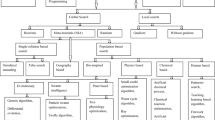Abstract
Abrasive waterjet (AWJ) machining is widely applied in the fields of civil and mechanical engineering. In this study, a general and theoretical analysis procedure was presented before computing application. It mainly focused on the kinetic energy model and wear rate model in machining process. Then, the multi-objective cuckoo algorithm was employed for optimization design of AWJ cutting head model, making sure to maximize the output energy and minimize the nozzle erosion rate while keeping the other factors constant. To demonstrate the effectiveness of the above strategy, a practical AWJ machining system was selected for investigation purpose. The proposed model was compared with experimental data for investigating the difference between the initial design and the optimized model. The results showed that the multi-objective cuckoo algorithm has great ability in prediction of outlet power and wear rate. Meanwhile, the optimized parameters were also superior to the original design, compared with experimental test data. The developed model can be used as a systematic approach for prediction in an advanced manufacturing process.
Similar content being viewed by others
Change history
01 November 2019
Author Meiping Wu wmp169@jiangnan.edu.cn should also be declared as the corresponding author of the article https://doi.org/10.1007/s00170-018-2549-x.
01 November 2019
Author Meiping Wu wmp169@jiangnan.edu.cn should also be declared as the corresponding author of the article https://doi.org/10.1007/s00170-018-2549-x.
References
Momber AW (2004) Wear of rocks by water flow. Int J Rock Mech Min Sci 41(1):51–68
Oh TM, Cho GC (2016) Rock cutting depth model based on kinetic energy of abrasive waterjet. Rock Mech Rock Eng 49(3):1059–1072
Nguyen T, Wang J, Li W (2015) Process models for controlled-depth abrasive waterjet milling of amorphous glasses. Int J Adv Manuf Technol 77(5–8):1177–1189
Jegaraj JJR, Babu NR (2005) A strategy for efficient and quality cutting of materials with abrasive waterjets considering the variation in orifice and focusing nozzle diameter. Int J Mach Tool Manu 45(12–13):1443–1450
Momber AW (2001) Energy transfer during the mixing of air and solid particles into a high-speed waterjet: an impact-force study. Exp Thermal Fluid Sci 25(1–2):31–41
Axinte DA, Karpuschewski B, Kong MC, Beaucamp AT, Anwar S, Miller D, Petzel M (2014) High energy fluid jet machining (hefjet-mach): from scientific and technological advances to niche industrial applications. CIRP Ann Manuf Technol 63(2):751–771
Nanduri M, Taggart DG, Kim TJ (2000) A study of nozzle wear in abrasive entrained water jetting environment. J Tribol 122(2):465
Beck F, Eberhard P (2015) Predicting abrasive wear with coupled lagrangian methods. Comput Part Mech 2(1):51–62
Syazwani H, Mebrahitom G, Azmir A (2016) A review on nozzle wear in abrasive water jet machining application. IOP Conf Ser Mater Sci Eng 114(1):012020
Deris AM, Zain AM, Sallehuddin R (2013) Hybrid gr-svm for prediction of surface roughness in abrasive water jet machining. Meccanica 48(8):1937–1945
Jagadish, Bhowmik S, Ray A (2015) Prediction of surface roughness quality of green abrasive water jet machining: a soft computing approach. J Intell Manuf 1:1–15
Pawade RS, Joshi SS (2011) Multi-objective optimization of surface roughness and cutting forces in high-speed turning of inconel 718 using taguchi grey relational analysis (tgra). Int J Adv Manuf Technol 56(1–4):47–62
Yuvaraj N, Kumar MP (2015) Multiresponse optimization of abrasive water jet cutting process parameters using topsis approach. Adv Manuf Process 30(7):882–889
Yang XS, Deb S (2013) Multiobjective cuckoo search for design optimization. Comput Oper Res 40(6):1616–1624
Schwartzentruber, J., Narayanan, C., Papini, M., Liu, H. T. (2016) Optimized abrasive waterjet nozzle design using genetic algorithms. The 23rd International Conference on Water Jetting, At Seattle, USA
Guillerna AB, Axinte D, Billingham J (2015) The linear inverse problem in energy beam processing with an application to abrasive waterjet machining. Int J Mach Tool Manu 99(1):34–42
Narayanan C, Balz R, Weiss DA, Heiniger KC (2013) Modelling of abrasive particle energy in water jet machining. J Mater Process Technol 213(12):2201–2210
Osman AH, Mabrouki T, Thery B, Buisine D (2004) Experimental analysis of high-speed air–water jet flow in an abrasive water jet mixing tube. Flow Meas Instrum 15(1):37–48
Pi VN, Tuan NQ (2009) A study on nozzle wear modeling in abrasive waterjet cutting. Adv Mater Res 76-78:345–350
Mohamad A, Zain AM, Bazin NE, Udin A (2015) A process prediction model based on cuckoo algorithm for abrasive waterjet machining. J Intell Manuf 26(6):1247–1252
Civicioglu P, Besdok E (2013) A conceptual comparison of the cuckoo-search, particle swarm optimization, differential evolution and artificial bee colony algorithms. Artif Intell Rev 39(4):315–346
Prisco U, D'Onofrio MC (2008) Three-dimensional CFD simulation of two-phase flow inside the abrasive water jet cutting head. Int J Comput Method Eng Sci Mech 9(5):300–319
Huang J, Gao L, Li X (2015) An effective teaching-learning-based cuckoo search algorithm for parameter optimization problems in structure designing and machining processes. Appl. Soft Comput. 36:349-356
Hashish M (1991) Optimization factors in abrasive-waterjet machining. J Eng Ind 113(1):29–37
Balz R, Mokso R, Narayanan C, Weiss DA, Heiniger KC (2013) Ultra-fast x-ray particle velocimetry measurements within an abrasive water jet. Exp Fluids 54(3):1476
Funding
This work is financially supported by National Natural Foundation Program (51575237) and 2016 International Cooperation & Training Program for Creative Talents (File No. 201600090095). The authors also thank Dr. Sawhney for his assistance in giving advise on conducting the simulation experiments.
Author information
Authors and Affiliations
Corresponding author
Rights and permissions
About this article
Cite this article
Qiang, Z., Miao, X., Wu, M. et al. Optimization of abrasive waterjet machining using multi-objective cuckoo search algorithm. Int J Adv Manuf Technol 99, 1257–1266 (2018). https://doi.org/10.1007/s00170-018-2549-x
Received:
Accepted:
Published:
Issue Date:
DOI: https://doi.org/10.1007/s00170-018-2549-x




